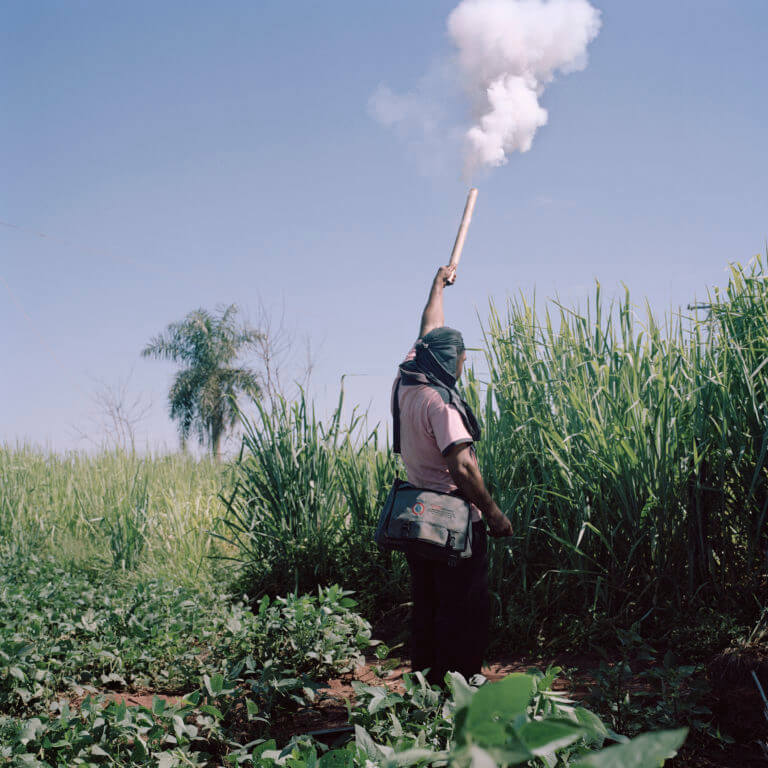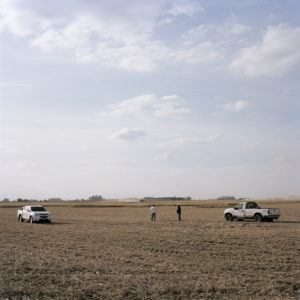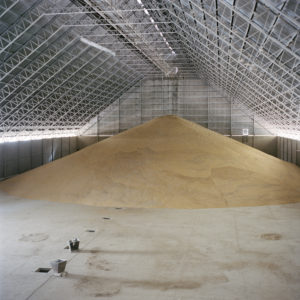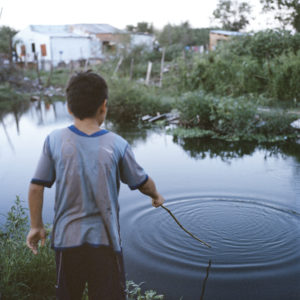

A campesino shots a firecracker to alert the population that a fumigation is happening near the community. Local residents would invade the soy field in order to stop the fumigation, since they consider it to be against the community environment and its populations health. On a similar situation two weeks before the police protected the fumigation and heavily repressed the peasants leaving several injured.

Neighbours at the community of Tacuapy Guazú watch one of it's neighbours soy plantation.

Burned traces of Guayaqui Cuá community after its eviction two days before. 22 families were evicted and their properties burned by nearby cattle-ranch security men working together with local police officers allegedly on behalf of the large-estate owner who directs the ranch. According to government authorities the lands are owned by the government but the large-estate owner has been expanding his property and claims ownership over the area where peasants were living.

A soya field in the heavily depopulated area of Minga Pora. One of the neighbors explains there used to be 72 families on this street, while now only 6 remain.

A group of men unload tree trunks to be turned into charcoal in a brick oven in Pampa del Infierno, Chaco Province. Charcoal production is a big issue in the region as it is both a cause and a result of the growing deforestation of the wider Chaco area. Local organisations believe the need for new land to use for agribusiness drives the deforestation in the Province. Dozens of charcoal production sites can be seen in this small town where local sources state the forest surface area has reduced from 70% to 20% in the last 20 years

Juan Vacarezza on a horse at the El Mediodía farm in Bragado, Buenos Aires Province. The Bragado family has occupied this land since the end of the 19th century. Currently they have over 1800ha of land, which they use to produce corn and soya. They also keep 350 horses for contests and shows, and employ an in-house horse breaker

A landowner and manager of harvesting machines meet on a soya field while a harvest takes place. Rojas, Buenos Aires Province

Fernando del Solar, an agricultural producer from Buenos Aires, checks a soya field in his property in Rojas, Argentina. His European ancestors settled there and built a house in 1882; they have been working the land since.
Similar to other large producers, Fernando says the previous government of Cristina Kirchner was really bad for the agribusiness sector, especially in terms of the limitations imposed on exportation and export taxes. He believes that with the recently appointed Mauricio Macri Government, which has already eliminated both export limitations and taxes in a move to further ease international commerce, small towns and the Argentinian countryside in general will boom, as well as employment across the country

Campesinos at the community of Crescencio Gonzalez harvest sesame

A pesant at La Terza Cué community remains jobless as the fields the community once owned are now part of a large soy plantation. They are on an ongoing conflict over the ownership of the land with the plantation company, which they accuse of steadily grabbing their lands in connivence from corrupted authorities. They also face pressure from a Rural Police group they accuse of acting on behalf of the company, as well as threats and economic pressure to leave the area. Since 2003 there had been 11 unsolved murders in the community, all by hit mans. Land grabbing and concentration of land sometimes in foreign hands is reported by national and international organizations to be one of Paraguay's major problems.

Inside the test room at agricultural and agro-industrial biotechnology company Bioceres where crops with different genetically modified makeups are tested. Bioceres is a market leader in Argentina and holds a strong position in South America. The first genetically modified wheat was developed here, and is due to be released in Argentina in 2016

A group of teenagers swim in river near Tava Jopoy community. Neighbors claim it's severely polluted due to pesticides used in the neighboring large estate plantations, with whom the they are on an ongoing conflict with regular protests against the fumigations

A group of young men kill time in Aviá Teraí, Chaco Province. Large-estate soya plantations surround the town, which has a population of around 6000 and no running water. Unemployment rates here are very high and a large number of the inhabitants live off of government handouts

A silo full of corn at Puerto Gical, one of the main private ports on the river Paraguay near Asunción, which gives way to the growing exports in the country. Soya, cereals and meat exports placed Paraguay as one of the fastest growing economies of Latin America, reaching a historical 13% GDP growth in 2013, one of the biggest in the world.

A view of Puerto Vicentín in San Lorenzo, Santa Fe Province. In 2007, Vicentín, a leader in the production, transportation and export of agricultural commodities in the country, became the first Argentinian company to export biodiesel. Today, the port can load as many as 270 ships per year and also transports and exports soybeans arriving from Paraguay

The girls of the Bragado family look after the horses at the El Mediodía family farm in Bragado, Buenos Aires Province. The family has occupied this land since the end of the 19th century. Currently they have over 1800ha of land, which they use to produce corn and soya. They also keep 350 horses for contests and show, and employ two in-house horse breakers

JRC16-ARG2-46 002

Cars due to be repaired outside a derelict house in Gancedo, Chaco Province. Several men who came to the town to work in the carpentry and woodwork industry share the house. While the jobs and population in most towns and small villages in this area are decreasing, Gancedo is growing, according to its mayor. This is due in part to the recently implemented supply of drinking water and opportunities in agribusiness and the woodwork industry

Inhabitants of the Pozo Barranquero community in Santiago del Estero drink mate in their house. The family has been living in this house for over 100 years, but they never had ownership rights to the property. In 2003, a person who held these rights and for the entire area, arrived and requested they leave. The owner began cutting down part of the forest as he intended to use the land for cattle ranching. The 14 families that remain in the area are embroiled in an ongoing legal battle with the new proprietor and are trying to uphold their right to live on the land

Fabian Tomasi, 50, in his house in Basavilbaso, Entre Ríos. Fabian, a former airplane fumigation company worker, has developed severe toxic polyneuropathy, dermatomyositis and type 1 diabetes, which he attributes to exposure to pesticides during his working years. He says he used to work without protection and adds that two of his former colleagues became blind. The two company owners died of cancer, he says, which he also attributes to the pesticides. Previously weighing 90kg, he currently weighs 45kg and can barely walk as a result of his degenerative diseases. He lives with his 20-year-old daughter and 80-year-old mom who look after him, and he strongly campaigns against the use of agrochemicals in Argentinian fields from his computer at home.

A soya field after harvest in Rojas, Buenos Aires Province

A kid fishing in the urban indigenous community of Campo Aguaré, which hosts 60 families living on a makeshift camp on the riverbed of Asunción. Most of its inhabitants came after losing their lands or after internal conflicts over renting them for soya production.
There are currently 700 unaccompanied kids on the streets of Asunción, living mostly of begging.

Juan Ramón, 16, takes a bath on a barrel in front of their makeshift home in the streets of Asunción where he has been for eight months together with his family. They were living in the “bañado”, the area surrounding the river until recent floods resulting from El Niño, as well as deforestation due to agribusiness further up the river forced them to evacuate.

Landless farmers camp in plastic huts in front of the Institute for Rudal Land Development in demand for lands to work. They state police evicted them from their lands without notice, as nearby soya plantation owner claimed ownership over the lands they had been living for over 20 years in Maria Auxiliadora community. Multiple ownership of lands is a widespread problem in Paraguay, where different property titles exist for the same area

Lights of Terminal 6 Port illuminate the sky. The port, located on the Paraná River on the outskirts of Rosario, bills itself as “most important agro-industrial export complex in Latin America”. Its strategic location within the navigable area of the Paraná River allows it to export worldwide via large vessels but also to receive raw material from Paraguay, which is transformed and then exported, providing important revenue































